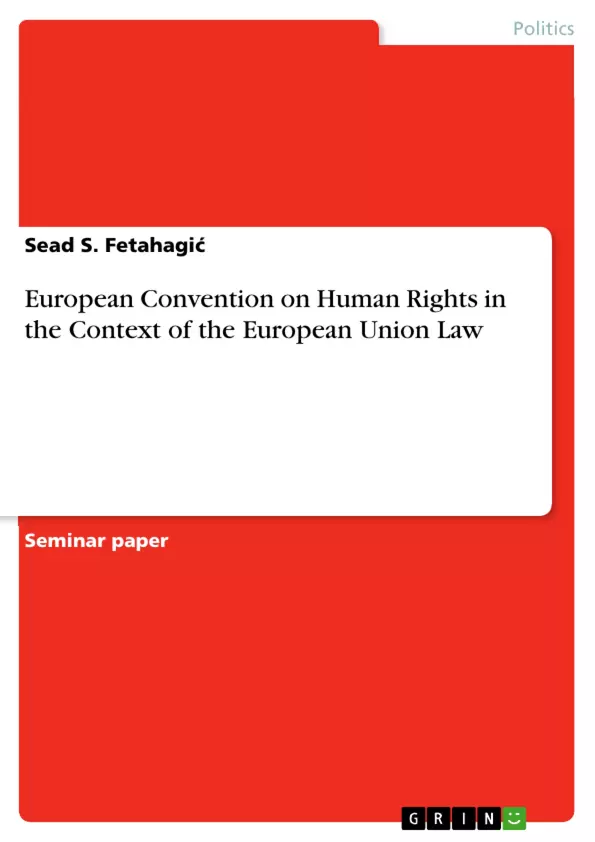The paper offers a review of a parallel development of two distinct but increasingly overlapping systems of the protection of human rights, the one under the auspices of the Council of Europe and its European Convention on Human Rights and the other integrated within the Community Law of the European Communities and later the European Union.
The former established the individual citizen as the subject of international law, who may seek protection for alleged violations of his/her rights directly from the European Court of Human Rights in Strasbourg. This system operates relatively efficiently since it is based on the largely universally accepted political principles of democracy and human rights by all member states of the Council of Europe. In contrast, the Community Law system is concerned more with economic and social rights of the European Union citizens. Given a specific supra-national legal system of the European Union some of its norms may collide with the European Convention on Human Rights as well as with national constitutions of EU member states.
Under the doctrine of "surrendered sovereignty" the European Court of Justice is authorized to issue direct orders to national courts when applying the Community Law. This is not the case with the European Court of Human Rights, which can act only on an individual case-to-case basis without giving preliminary judgements on national laws in general. Moreover, the two courts gave different interpretations of certain provisions of the European Convention on Human Rights in the past and issued contradictory judgements.
To avoid such problems, some have proposed an idea that, despite the fact that all EU member states have signed the European Convention on Human Rights, the European Union as an entity should do the same in order to ensure uniformity of legal interpretations and judicial practice, which again raises questions on the legal nature of the European Union.
Inhaltsverzeichnis (Table of Contents)
- BACKGROUND
- EUROPEAN CONVENTION ON HUMAN RIGHTS – THE INDIVIDUAL AS THE SUBJECT OF INTERNATIONAL LAW
- EUROPEAN UNION IN BRIEF
- THE CONVENTION AND THE COMMUNITY LAW
- CONCLUSION - EUROPEAN UNION TO SIGN THE CONVENTION?
- REFERENCES:
Zielsetzung und Themenschwerpunkte (Objectives and Key Themes)
This seminar paper aims to explore the European Convention on Human Rights (ECHR) within the context of the European Union (EU), examining its significance for the development of international human rights law and its relationship with Community law.
- The historical development of the ECHR and its importance in the post-World War II era.
- The ECHR's impact on international human rights law, particularly the recognition of individuals as subjects, not objects, of international law.
- The relationship between the ECHR and EU law, including potential areas of conflict and harmonization.
- The significance of the ECHR in promoting human rights and fundamental freedoms within the EU.
Zusammenfassung der Kapitel (Chapter Summaries)
- BACKGROUND: This section traces the origins of European integration back to the aftermath of World War II, highlighting the establishment of the Council of Europe as a key milestone in the process. It explains the Council's core aims and its intergovernmental structure, emphasizing the role of conventions and recommendations in its activities.
- EUROPEAN CONVENTION ON HUMAN RIGHTS – THE INDIVIDUAL AS THE SUBJECT OF INTERNATIONAL LAW: This chapter focuses on the adoption and implementation of the ECHR. It emphasizes the significant shift in international law, whereby individuals are now recognized as subjects, not just objects, of international law. The ECHR's provisions, including the right to lodge complaints against signatory states, are discussed, alongside the establishment of the European Commission and Court of Human Rights as key mechanisms for enforcing these rights.
- EUROPEAN UNION IN BRIEF: This section offers a concise overview of the EU, focusing on its history, structure, and key principles. It provides a context for understanding the ECHR's interaction with Community law.
- THE CONVENTION AND THE COMMUNITY LAW: This chapter delves into the relationship between the ECHR and EU law. It analyzes potential areas of overlap, conflict, and harmonization, highlighting the challenges and opportunities presented by integrating these two legal systems.
Schlüsselwörter (Keywords)
The main keywords and focus topics of this seminar paper include the European Convention on Human Rights, the Council of Europe, international human rights law, the European Union, Community law, individual rights, fundamental freedoms, legal protection, and intergovernmental organizations.
- Quote paper
- Sead S. Fetahagić (Author), 2003, European Convention on Human Rights in the Context of the European Union Law, Munich, GRIN Verlag, https://www.grin.com/document/355441



